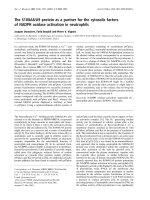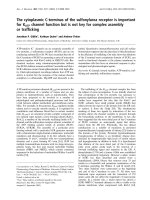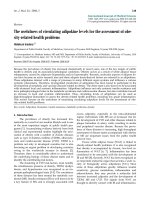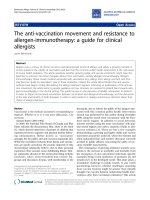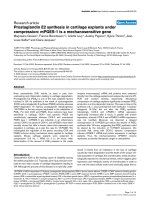Báo cáo y học: "The Utstein template for uniform reporting of data following major trauma: A valuable tool for establishing a pan-European dataset" docx
Bạn đang xem bản rút gọn của tài liệu. Xem và tải ngay bản đầy đủ của tài liệu tại đây (166.43 KB, 2 trang )
BioMed Central
Page 1 of 2
(page number not for citation purposes)
Scandinavian Journal of Trauma,
Resuscitation and Emergency Medicine
Open Access
Commentary
The Utstein template for uniform reporting of data following major
trauma: A valuable tool for establishing a pan-European dataset
Karim Brohi
Address: Trauma and Vascular Surgery, Barts and the London NHS Trust, London, UK
Email: Karim Brohi -
Trauma is a public health problem of global importance.
Central to any public health approach in tackling a disease
is research, and central to any research is high quality data.
Trauma systems – local, regional, national or interna-
tional – are driven by the completeness and quality of
data they collect and analyze. The performance improve-
ment cycle of system assessment, policy development and
quality assurance is dependent on the informatics infra-
structure that supports it. Solid, quality data is a powerful
tool in improving care, for clinicians, administrators and
politicians.
Trauma registries are therefore key elements of any public
health approach to managing severe injury. The past two
decades have seen several European countries recognise
the importance of this and successfully develop their own
national registries. Each country continues to face its own
difficulties with regard to completeness, data quality and
funding for informatics management. Nevertheless, a
recent publication by Ringdal et al [1] have recognised the
enticing potential of a pan-European registry. The value of
these datasets increases almost exponentially with the
amount of data collected. Beyond simple size implica-
tions, a pan-European dataset will allow comparison of
different methods of delivering trauma care, Europe-wide
programmes for clinical research and large-scale funding
and policy development. Reminiscent of the spirit of the
European Union the authors have not attempted to foist a
single tool on all members, but rather attempted to agree
a core dataset common to all which can be built on to
respond to the specific needs of individual states.
The Utstein Group have attempted to reduce the core
dataset from 92 parameters to only 35. There are rational
arguments for doing so, and a smaller dataset is more
likely to be collected in its entirety. Some datapoints are
redundant, and coupled so closely to others that their util-
ity is minimal. Some datapoints provide no information
on outcomes, system characteristics or process of care.
Some are superseded by newer measures or tools. Both the
reasoning behind the reduction in parameters, and the
methodology by which the Utstein participants have pro-
ceeded are robust, and the resultant dataset is interesting
for its conciseness in what it contains – and in what has
been left out.
But is this reductionist approach the right one for our
times? Can this 35-point dataset tell us not only that out-
comes are different in different systems but why? Will they
allow rational trial design? Will they ensure that funding
is targeted to the right regions and system components?
More than likely they will provide a simplistic overview,
which may be suggestive, and may be wrong. Making sen-
sible decisions about the delivery of care, outcomes after
severe injury or planning clinical trials requires more, not
less data. And not a little but more but tens or hundreds
of times more data items than we currently have. It is a
conceit to think that a simple scoring system for injury
severity, and a single-time point assessment of physiology
can really reflect the true state of a patient on arrival.
Trauma is a dynamic process – patients may be improving
or deteriorating on arrival. Standard registry data pays no
attention to this and little attention to the response to
resuscitative manoeuvres. And while functional outcomes
are harder and more costly to measure, they must be more
valuable and descriptive of patient injuries and the care
they received.
Published: 28 August 2008
Scandinavian Journal of Trauma, Resuscitation and Emergency Medicine 2008, 16:8 doi:10.1186/1757-7241-16-8
Received: 21 July 2008
Accepted: 28 August 2008
This article is available from: />© 2008 Brohi; licensee BioMed Central Ltd.
This is an Open Access article distributed under the terms of the Creative Commons Attribution License ( />),
which permits unrestricted use, distribution, and reproduction in any medium, provided the original work is properly cited.
Publish with BioMed Central and every
scientist can read your work free of charge
"BioMed Central will be the most significant development for
disseminating the results of biomedical research in our lifetime."
Sir Paul Nurse, Cancer Research UK
Your research papers will be:
available free of charge to the entire biomedical community
peer reviewed and published immediately upon acceptance
cited in PubMed and archived on PubMed Central
yours — you keep the copyright
Submit your manuscript here:
/>BioMedcentral
Scandinavian Journal of Trauma, Resuscitation and Emergency Medicine 2008, 16:8 />Page 2 of 2
(page number not for citation purposes)
Much of this data can now be collected automatically,
given the appropriate equipment and infrastructure. Pre-
hospital data can be downloaded wirelessly from a para-
medic's PDA as soon as they come within wireless range
of the admitting hospital. Physiological data, drug and
blood product administration can all be tagged electroni-
cally, as can the patient's position within the hospital.
Other databases, such as ICU, pathology and radiology
systems already collect much of the diagnostics, morbid-
ity and outcome data on these patients. We have enough
computer processing power and data storage for these
needs. New statistical and data-mining techniques allow
for the combination of such databases, the management
of missing data and the sensible exploration of large-scale
data.
For now, both approaches are valid. A robust, clearly
defined core dataset common to all will be a very valuable
tool. It will be interesting to see whether this smaller data-
set will allow more complete data collection on larger
numbers of patients, and whether valuable analyses can
be derived from it. Important for this will be legislative
policy at national and European levels to support the
development of an informatics infrastructure for trauma
and the collection of such data on a population-wide
basis. However, we must rapidly move towards a whole-
system approach to data collection, for it is only in the
complexity of our trauma patients, and the multitude of
interventions they are exposed to, that the true future of
trauma care resides.
Competing interests
The author declares that they have no competing interests.
References
1. Ringdal KG, Coats TJ, Lefering R, Di Bartolomeo S, Steen PA, Røise
O, Handolin L, Lossius HM: The Utstein Template for Uniform
Reporting of Data following Major Trauma. A joint revision
by SCANTEM, TARN, DGU-TR, and RITG. Scand J Trauma
Resusc Emerg Med 2008, 16:7.


